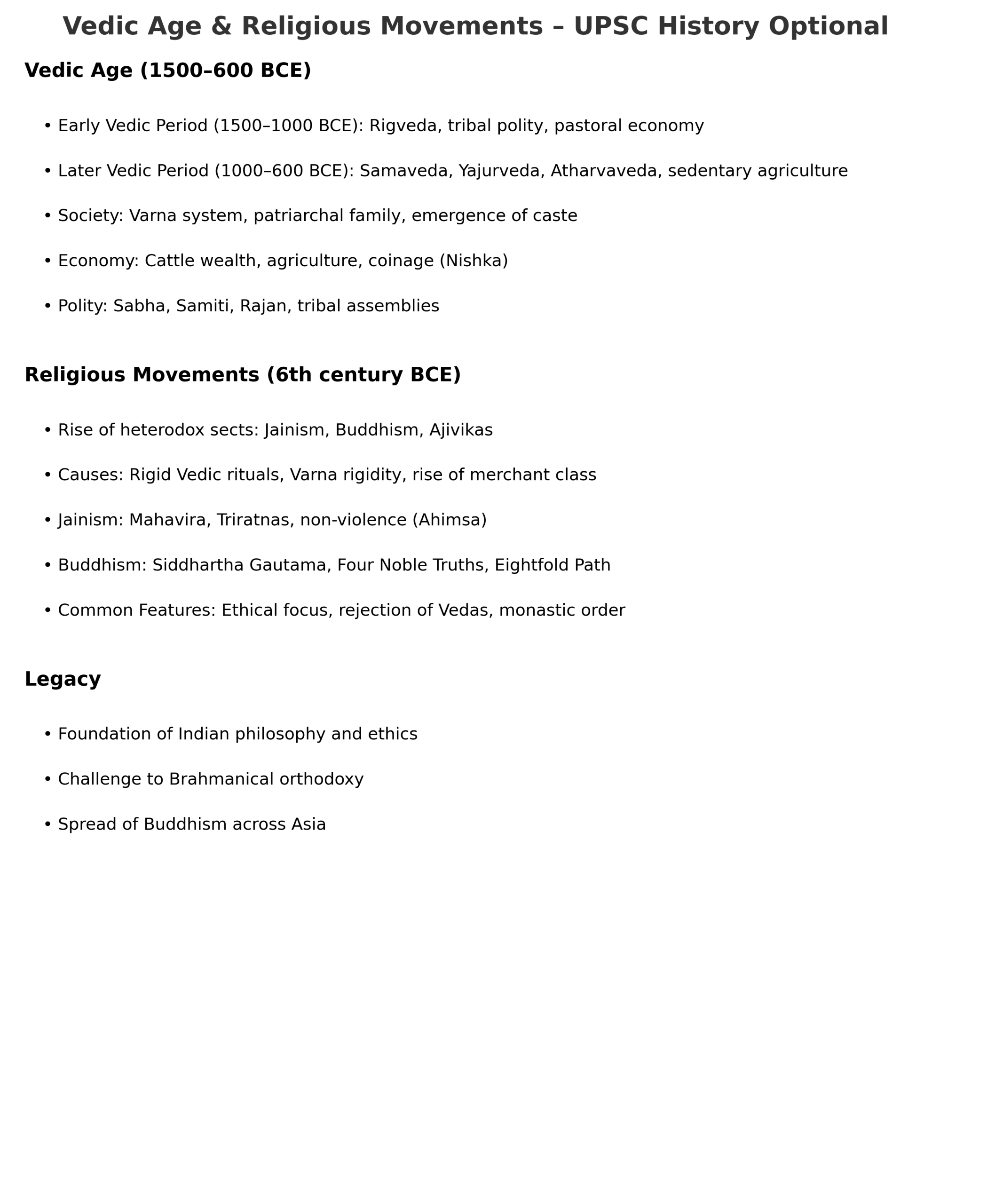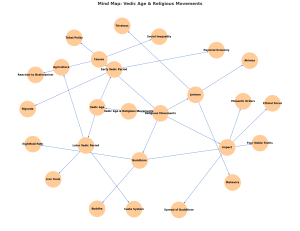
22 Jul Vedic Age & Religious Movements
Vedic Age & Religious Movements – UPSC History Optional Paper 1
Introduction
The Vedic Age and the Religious Movements of the 6th century BCE are pivotal periods in Indian history. The Vedic Age laid the foundational framework of social and political life in ancient India. The Religious Movements, especially Buddhism and Jainism, challenged the Vedic orthodoxy and reshaped Indian philosophy and society. Together, they form a critical area in Paper 1 of the UPSC History Optional syllabus.
1. The Vedic Age (c. 1500 BCE – 600 BCE)
The Vedic Age is marked by the migration and settlement of the Indo-Aryans in north-western India. It is divided into two broad phases:

Vedic and religios movements
1.1 Early Vedic Period (c. 1500–1000 BCE)
- Main Source: Rigveda – the oldest literary text of India
- Geography: Sapta Sindhu (Land of Seven Rivers)
- Polity:
- Tribal polity with elected chiefs (Rajan)
- Assemblies: Sabha (Council of Elders), Samiti (General Assembly)
- Economy:
- Pastoral economy – cows as wealth (Gavya Dhan)
- No taxes, economy based on cattle exchange
- Society:
- Patriarchal and tribal
- Varna concept beginning to emerge (Brahmana, Kshatriya, Vaishya, Shudra)
- Religion:
- Nature worship – Indra, Agni, Varuna
- No idol worship or temples
1.2 Later Vedic Period (c. 1000–600 BCE)
- Main Texts: Samaveda, Yajurveda, Atharvaveda, Brahmanas, Upanishads
- Geography: Expansion into the Ganga-Yamuna Doab
- Polity:
- Rise of hereditary monarchy
- Decline of tribal assemblies
- Economy:
- Agricultural base developed
- Use of iron tools and plough
- Emergence of coins (Nishka, Satamana)
- Society:
- Varna system became rigid
- Position of women declined
- Gotra and Ashrama systems emerged
- Religion and Philosophy:
- Complex rituals, sacrifices (Yajnas)
- Emergence of philosophical thoughts in Upanishads – Brahman, Atman, Moksha
2. Religious Movements of the 6th Century BCE
The 6th century BCE witnessed an intellectual revolution with the rise of heterodox sects like Jainism and Buddhism. These movements emerged in reaction to the ritualistic practices of Vedic Brahmanism.
Best history optional coaching in delhi
best history optional test series
2.1 Causes for the Rise
- Complex Vedic rituals and dominance of Brahmanas
- Economic growth and rise of mercantile class who supported simpler faiths
- Reaction against social inequality (caste oppression)
- Influence of new agricultural economy in Eastern India
2.2 Jainism
- Founder: Vardhamana Mahavira (24th Tirthankara)
- Core Philosophy: Triratnas – Right Faith, Right Knowledge, Right Conduct
- Principles:
- Ahimsa (Non-violence)
- Anekantavada (Multiplicity of truth)
- Asceticism and renunciation
- Texts: Jain Agamas (in Prakrit)
- Sects: Digambaras and Shvetambaras
2.3 Buddhism
- Founder: Gautama Buddha (Siddhartha)
- Four Noble Truths (Arya Satya):
- Dukkha (Life is suffering)
- Dukkha Samudaya (Cause is desire)
- Dukkha Nirodha (End of suffering is Nirvana)
- Path: Ashtangika Marga (Eightfold Path)
- Key Doctrines: Karma, Rebirth, Nirvana, Middle Path
- Texts: Tripitakas (Vinaya, Sutta, Abhidhamma)
- Sects: Theravada and Mahayana
- Patronage: Bimbisara, Ashoka, Kanishka
2.4 Common Features of Jainism and Buddhism
- Rejection of Vedic authority and caste hierarchy
- Simple ethical life and emphasis on morality
- Support from commoners and merchants
- Monastic community (Sangha)
- Spoke in Prakrit and Pali – closer to common people
3. Impact and Legacy
- Ethical framework for Indian thought
- Spread of Buddhism to Central, East, and Southeast Asia
- Art and architecture (e.g., Stupas, rock-cut caves)
- Religious pluralism and spiritual liberalism in Indian tradition
Previous Year Questions – UPSC History Optional
- 2021: Examine the social and religious conditions that gave rise to new religious movements in the 6th century BCE.
- 2019: Evaluate the contribution of the Later Vedic literature in understanding social structure.
- 2017: Discuss the nature of political organization in the Rigvedic period.
- 2014: Assess the importance of Jainism and Buddhism in shaping Indian cultural identity.
Probable Questions for UPSC Mains 2025
- How did the transition from Early to Later Vedic period alter the socio-political landscape of India?
- Compare and contrast the philosophies of Jainism and Buddhism.
- Examine the role of economic and geographical factors in the rise of religious heterodoxy in the 6th century BCE.
- Discuss the contribution of Buddhist Sangha in spreading Indian culture abroad.
Infographic Download
Conclusion
The Vedic Age laid the foundation of Indian social and religious institutions, while the 6th-century BCE religious movements provided an alternative spiritual path emphasizing ethics and equality. Together, they represent continuity and change in ancient Indian thought. For UPSC aspirants, understanding this synthesis is essential for mastering the evolution of early Indian society and philosophy.




No Comments